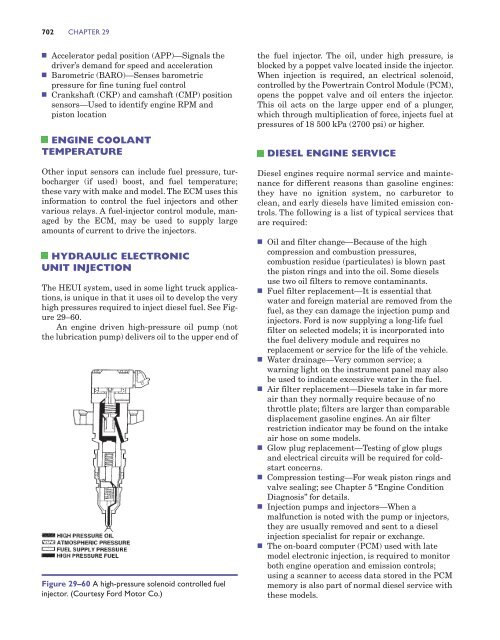Gasoline and Diesel Fuel Injection: Operation ... - Pearson Canada
Gasoline and Diesel Fuel Injection: Operation ... - Pearson Canada
Gasoline and Diesel Fuel Injection: Operation ... - Pearson Canada
Create successful ePaper yourself
Turn your PDF publications into a flip-book with our unique Google optimized e-Paper software.
702 CHAPTER 29<br />
■ Accelerator pedal position (APP)—Signals the<br />
driver’s dem<strong>and</strong> for speed <strong>and</strong> acceleration<br />
■ Barometric (BARO)—Senses barometric<br />
pressure for fine tuning fuel control<br />
■ Crankshaft (CKP) <strong>and</strong> camshaft (CMP) position<br />
sensors—Used to identify engine RPM <strong>and</strong><br />
piston location<br />
ENGINE COOLANT<br />
TEMPERATURE<br />
Other input sensors can include fuel pressure, turbocharger<br />
(if used) boost, <strong>and</strong> fuel temperature;<br />
these vary with make <strong>and</strong> model. The ECM uses this<br />
information to control the fuel injectors <strong>and</strong> other<br />
various relays. A fuel-injector control module, managed<br />
by the ECM, may be used to supply large<br />
amounts of current to drive the injectors.<br />
HYDRAULIC ELECTRONIC<br />
UNIT INJECTION<br />
The HEUI system, used in some light truck applications,<br />
is unique in that it uses oil to develop the very<br />
high pressures required to inject diesel fuel. See Figure<br />
29–60.<br />
An engine driven high-pressure oil pump (not<br />
the lubrication pump) delivers oil to the upper end of<br />
Figure 29–60 A high-pressure solenoid controlled fuel<br />
injector. (Courtesy Ford Motor Co.)<br />
the fuel injector. The oil, under high pressure, is<br />
blocked by a poppet valve located inside the injector.<br />
When injection is required, an electrical solenoid,<br />
controlled by the Powertrain Control Module (PCM),<br />
opens the poppet valve <strong>and</strong> oil enters the injector.<br />
This oil acts on the large upper end of a plunger,<br />
which through multiplication of force, injects fuel at<br />
pressures of 18 500 kPa (2700 psi) or higher.<br />
DIESEL ENGINE SERVICE<br />
<strong>Diesel</strong> engines require normal service <strong>and</strong> maintenance<br />
for different reasons than gasoline engines:<br />
they have no ignition system, no carburetor to<br />
clean, <strong>and</strong> early diesels have limited emission controls.<br />
The following is a list of typical services that<br />
are required:<br />
■ Oil <strong>and</strong> filter change—Because of the high<br />
compression <strong>and</strong> combustion pressures,<br />
combustion residue (particulates) is blown past<br />
the piston rings <strong>and</strong> into the oil. Some diesels<br />
use two oil filters to remove contaminants.<br />
■ <strong>Fuel</strong> filter replacement—It is essential that<br />
water <strong>and</strong> foreign material are removed from the<br />
fuel, as they can damage the injection pump <strong>and</strong><br />
injectors. Ford is now supplying a long-life fuel<br />
filter on selected models; it is incorporated into<br />
the fuel delivery module <strong>and</strong> requires no<br />
replacement or service for the life of the vehicle.<br />
■ Water drainage—Very common service; a<br />
warning light on the instrument panel may also<br />
be used to indicate excessive water in the fuel.<br />
■ Air filter replacement—<strong>Diesel</strong>s take in far more<br />
air than they normally require because of no<br />
throttle plate; filters are larger than comparable<br />
displacement gasoline engines. An air filter<br />
restriction indicator may be found on the intake<br />
air hose on some models.<br />
■ Glow plug replacement—Testing of glow plugs<br />
<strong>and</strong> electrical circuits will be required for coldstart<br />
concerns.<br />
■ Compression testing—For weak piston rings <strong>and</strong><br />
valve sealing; see Chapter 5 “Engine Condition<br />
Diagnosis” for details.<br />
■ <strong>Injection</strong> pumps <strong>and</strong> injectors—When a<br />
malfunction is noted with the pump or injectors,<br />
they are usually removed <strong>and</strong> sent to a diesel<br />
injection specialist for repair or exchange.<br />
■ The on-board computer (PCM) used with late<br />
model electronic injection, is required to monitor<br />
both engine operation <strong>and</strong> emission controls;<br />
using a scanner to access data stored in the PCM<br />
memory is also part of normal diesel service with<br />
these models.

















